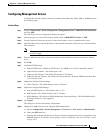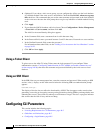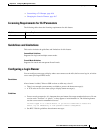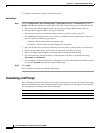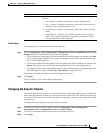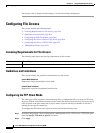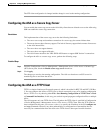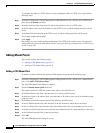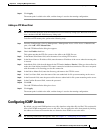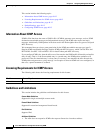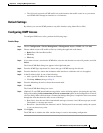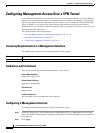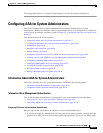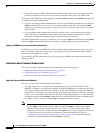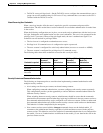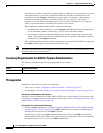
40-11
Cisco ASA 5500 Series Configuration Guide using ASDM
Chapter 40 Configuring Management Access
Configuring ICMP Access
Step 11 Click Apply.
The mount point is added to the ASA, and the change is saved to the running configuration.
Adding an FTP Mount Point
Note For an FTP mount point, the FTP server must have a UNIX directory listing style. Microsoft FTP servers
have a default of the MS-DOS directory listing style.
To define an FTP mount point, perform the following steps:
Step 1 From the Configuration > Device Management > Management Access > File Access > Mount-Points
pane, click Add > FTP Mount Point.
The Add FTP Mount Point dialog box appears.
Step 2 Check the Enable check box.
This option attaches the FTP file system on the ASA to the UNIX file tree.
Step 3 In the Mount Point Name field, enter the name of an existing FTP location.
Step 4 In the Server Name or IP Address field, enter the name or IP address of the server where the mount point
is located.
Step 5 In the Mode field, click the radio button for the FTP mode (Active or Passive). When you choose Passive
mode, the client initiates both the FTP control connection and the data connection. The server responds
with the number of its listening port for this connection.
Step 6 In the Path to Mount field, enter the directory path name to the FTP file server.
Step 7 In the User Name field, enter the name of the user authorized for file system mounting on the server.
Step 8 In the Password field, enter the password for the user authorized for file system mounting on the server.
Step 9 In the Confirm Password field, reenter the password.
Step 10 Click OK.
The Add FTP Mount Point dialog box closes.
Step 11 Click Apply.
The mount point is added to the ASA, and the change is saved to the running configuration.
Configuring ICMP Access
By default, you can send ICMP packets to any ASA interface using either IPv4 or IPv6. This section tells
how to limit ICMP management access to the ASA. You can protect the ASA from attacks by limiting
the addresses of hosts and networks that are allowed to have ICMP access to the ASA.
Note For allowing ICMP traffic through the ASA, see Chapter 37, “Configuring Access Rules.”



